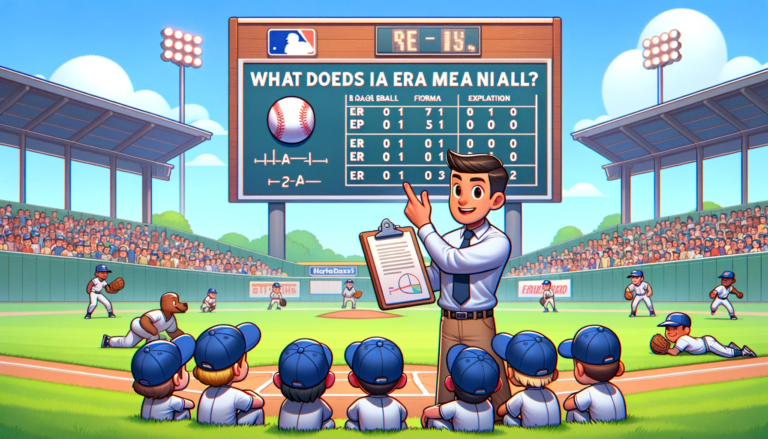How Long is a Baseball Game?
On average, a Major League Baseball game lasts around 3 hours. However, this can vary based on several factors such as the number of innings, the pace of the players, and whether there are any delays.
In this article, we’ll look at what affects the length of a baseball game and some tips on how to make the most of your viewing experience.
Key Takeaways
- The average duration of a Major League Baseball game has historically been around three hours, but recent rules, including the pitch clock, have reduced it to approximately two hours and 39 minutes.
- The fastest recorded Major League game occurred in 1919 and lasted just 51 minutes, highlighting the variability of game duration due to the absence of a fixed time limit.
- In 2023, significant rule changes were implemented to speed up the game, with the pitch clock being the most impactful, leading to the shortest average game time since 1985.
- A Major League Baseball typically lasts only about seven pitches before being replaced, reflecting the high standards of the game and the recycling of used baseballs.
- Baseball’s enduring appeal in American culture is tied to its traditions, the leisurely pace of play, and the generational connections it fosters, despite the push for shorter game times.
Understanding the Length of a Baseball Game
The Role of Innings in Game Duration
The structure of a baseball game is inherently tied to its duration, with each game traditionally consisting of nine innings.
An inning is further divided into two halves, where each team gets a chance to bat until three outs are made.
The number of innings is a fundamental factor in determining the overall length of a game. However, the time it takes to complete an inning can vary greatly.
Factors such as the number of pitches thrown, the strategies employed by the teams, and the pace at which players execute plays all contribute to the inning’s length.
Here’s a brief rundown of how innings can impact game duration:
- Pitch count: More pitches generally mean longer innings.
- Offensive strategies: Tactics like bunting or stealing bases can extend an inning.
- Defensive plays: Quick outs can significantly shorten inning times.
In recent years, the average length of a Major League Baseball game has hovered around three hours, with variations depending on the factors mentioned above.
For instance, the average length of a Major League Baseball game in 2020 was about 3 hours and 7 minutes.
This duration reflects not just the nine innings of play but also the time between innings and any potential extra innings that may occur. You may read also How Fast Can The Average Person Throw a Baseball
Historical Perspective on Game Length
The duration of Major League Baseball (MLB) games has seen significant changes over the years.
During the 1980s and 90s, games typically lasted around 2 hours and 50 minutes. This period is often looked back on with nostalgia, as it represents a time when games were considerably shorter than they are today.
In recent years, the average baseball game length has increased to about three hours and 10 minutes. This longer duration tested the patience of fans, especially in an era where attention spans are shorter.
The 2023 season marked a significant change with the introduction of the pitch clock. This new rule reduced the average game time to just two hours and 39 minutes. This is the shortest average since the 1985 season.
These changes in game duration show how baseball is evolving. They represent ongoing efforts to balance the sport’s classic appeal with the needs of today’s audience.
Recent Trends and Rule Changes
In recent years, Major League Baseball has implemented several rule changes aimed at reducing the duration of games and enhancing the viewer experience.
The introduction of a pitch clock has been a pivotal change, significantly decreasing the time between pitches.
This, along with other adjustments such as the elimination of the infield shift and the enlargement of bases, has led to a more dynamic and faster-paced game.
The impact of these changes is evident in the statistics: the average length of a game in the 2023 season was almost 24 minutes less than in 2022.
This marks a return to a swifter game not seen since the mid-1980s. The modifications have also encouraged a shift in strategy, with teams now placing a greater emphasis on speed and base-stealing.
While some purists may yearn for the days of complete games and strategic bunting, the consensus is that baseball is moving at a better pace, with even stolen bases making a notable comeback.
Here are some key points reflecting the recent trends and rule changes:
- Implementation of a pitch clock to reduce downtime between pitches.
- Elimination of the infield shift rule to promote hitting.
- Enlargement of bases to encourage base-stealing and speed on the field.
- A noticeable decrease in game duration, with the average time of a nine-inning game dropping to its shortest since 1985.
Read Also: Why is Softball Harder than Baseball
Record-Breaking Extremes
The Fastest Major League Game Ever Played
The record for the fastest major league baseball game is a testament to efficiency and speed.
On September 28, 1919, the New York Giants faced the Philadelphia Phillies in a match that concluded in a mere 51 minutes.
This game stands out not only for its brevity but also for the complete games thrown by both teams’ pitchers, with the Giants securing a 6-1 victory.
Generally, the average duration of a major league game hovers around three hours, making this sub-hour game an extraordinary occurrence in baseball history.
It’s a stark contrast to the games of today, which are often extended by strategic plays, commercial breaks, and various interruptions.
- Historical context: The game took place in 1919, a time when baseball was played at a brisker pace.
- Game outcome: The Giants won with a score of 6-1.
- Pitching prowess: Both teams’ pitchers completed the game, a rare feat in modern baseball.
Marathon Games: Pushing the Limits of Duration
Baseball games are known for their potential to stretch on for hours, but some games have truly tested the limits of endurance and patience.
Marathon games in baseball history have turned the sport into a test of stamina for players and fans alike.
One of the most notable examples is the longest professional baseball game recorded on Wikipedia, which began on April 18 and astonishingly continued into June.
The game spanned an incredible 33 innings, with the 32nd inning concluding on April 19 and the final inning played on June 23.
This epic encounter is a testament to the relentless nature of the sport where, traditionally, games must conclude with a clear winner, regardless of the time it takes.
In the Major League, the record for the longest game is held by a match between the Chicago White Sox and the Milwaukee Brewers.
This colossal game unfolded over 25 innings and lasted more than 8 hours, ultimately stretching across two days due to a league rule preventing new innings after 1 a.m.
Such games are rare, but they highlight the unpredictable and timeless nature of baseball, where a game can become a day-long affair or, in some cases, span multiple calendar days.
The Impact of Extra Innings on Game Length
Extra innings have a notable impact on the duration of baseball games. While a standard game is set for nine innings, any tie at the end of the ninth leads to extra innings until a winner is determined.
This can significantly extend the game time, often adding an unpredictable amount of time to the overall experience.
- The introduction of the pitch clock has reduced the average game time.
- Fewer games are reaching the lengthy marathon status of 3.5 hours or more.
- The average game length in 2023 was the shortest since the 1985 season.
Despite these efforts to speed up the game, extra innings remain a wildcard that can lead to extended play times.
While they add to the excitement for fans, they also challenge the initiatives aimed at shortening game durations.
Read Also: Do Baseballs Float
The Efforts to Speed Up the Game

Introducing the Pitch Clock
The introduction of the pitch clock in Major League Baseball has been a game-changer in efforts to speed up America’s pastime.
Pitchers now have a maximum of 15 seconds to throw with the bases empty, and 20 seconds with runners on base.
This has led to a significant reduction in game duration. The average nine-inning game has dropped to around 2 hours and 40 minutes, the shortest since 1985.
Key points of the pitch clock include:
- Pitchers must deliver the ball within the allotted time.
- Batters are required to be ready to hit within eight seconds.
- The clock is reduced to 18 seconds with baserunners, as of the latest update.
While the pitch clock has successfully decreased game times, it has not been without controversy.
The players’ union has raised concerns about the potential link between the faster pace and a series of pitcher injuries.
Despite this, the MLB continues to push for changes that make the game more exciting and appealing, especially to younger audiences. You may also read Why is Baseball So Boring
Rule Changes and Their Effects on Game Pace
The introduction of a pitch clock and other recent rule changes have had a noticeable impact on the pace of baseball games.
The average length of a game in the 2023 season was almost 24 minutes less than in 2022, indicating a significant shift towards a quicker experience.
These modifications were part of a broader effort to make baseball more appealing, especially to younger audiences.
Key changes include:
- The implementation of a pitch clock to reduce downtime between pitches.
- The elimination of the infield shift rule to encourage more hits and in-play action.
- Enlarging the bases to promote base-stealing and dynamic play.
While the game has become faster, some purists argue that the strategic depth of baseball may be compromised.
However, the consensus is that these changes have injected more excitement into the game. Stolen bases and strategic bunts are making a comeback.
The MLB’s efforts reflect a delicate balance. They aim to preserve the essence of baseball while evolving with the times. This helps maintain the sport’s relevance and entertainment value.
The Reception of New Rules by Players and Fans
The introduction of new rules in Major League Baseball has historically been met with a mix of anticipation and skepticism.
With the pitch timer, defensive shift restrictions, and bigger bases, the 2023 MLB season featured arguably the most ambitious series of rules changes since the sport’s early days.
These changes aimed to enhance the pace of the game and make it more engaging for a modern audience.
Players and fans alike have had varied reactions to these adjustments. Some traditionalists argue that the alterations may dilute the game’s strategic depth. Meanwhile, others appreciate the quicker pace and the resurgence of certain play styles.
Notably:
- The pitch clock has been praised for reducing downtime between pitches.
- Defensive shift restrictions have encouraged more traditional fielding positions.
- Larger bases have been linked to a slight increase in stolen base attempts.
Despite initial resistance, many within the baseball community have begun to see the benefits of these rules. They particularly notice the positive impact on game flow and excitement.
The ongoing dialogue between the league, players, and fans suggests that baseball’s evolution will continue to be a collaborative effort.
See Also: Is Baseball a Contact Sport
The Lifecycle of a Baseball During Play

The Average Lifespan of a Major League Baseball
The life of Major League Baseball is surprisingly short-lived.
Once a ball hits a bat or the ground, its time in play is typically over, averaging only about seven pitches before it’s considered unfit for official game use.
Despite their brief stint in the spotlight, these baseballs don’t go to waste.
The Major League Baseball organization is conscious of not being wasteful with these essential pieces of equipment.
Balls that are no longer game-worthy are:
- Repurposed for use in batting practice.
- Sent to minor league teams for their games and practices.
This recycling effort ensures that, while the balls may not see much action in a major league game, they continue to be a valuable resource for the sport at various levels.
How Baseballs are Recycled After Use
Once a baseball has served its purpose in a Major League game, it doesn’t just disappear into the abyss. The life of a baseball extends beyond the diamond, finding new roles in the sport.
Here’s what happens to those balls:
- Balls that are still in decent condition are used for batting practice, allowing players to hone their skills without depleting new stock.
- Those not fit for batting practice might be sent to minor league teams, where they can continue to be part of the game’s lifecycle.
- In some cases, baseballs are donated to charity or used in community outreach programs, furthering baseball’s impact beyond the professional sphere.
This recycling process ensures that the resources invested in each baseball are maximized, and it also reflects baseball’s commitment to sustainability.
It’s a small, yet significant, contribution to the sport’s legacy and its environmental responsibilities.
The Cost of Baseballs in the Major League
The economics of baseballs in the Major League is a fascinating aspect of the sport’s financial landscape.
Each baseball, with its short lifespan of about seven pitches, represents a recurring expense. Teams must balance the need for a large supply of baseballs with the costs associated with them.
- The average baseball is quickly retired from play after hitting a bat or the dirt.
- Major League Baseball (MLB) ensures that used balls are not wasted; they are often repurposed for batting practice or sent to minor league teams.
For fans, the allure of owning a piece of the game can come at a premium. Game-used or autographed baseballs often find their way to MLB Auctions, where they are sold to the highest bidder.
This not only recycles the baseballs but also turns them into memorabilia that can fetch a significant price.
Read Also: Why Do Baseball Players Chew Gum
Conclusion
In conclusion, a typical Major League Baseball game takes about three hours to complete. However, the actual length can vary due to different factors like the playing style, extra innings, or unexpected delays.
Understanding these aspects can help you better plan your day around watching a game.
Whether you’re a die-hard fan or just tuning in for a casual watch, knowing how long a game lasts makes it easier to enjoy without disrupting your schedule.
Frequently Asked Questions
What is the average duration of a Major League Baseball game?
The average duration of a Major League Baseball game is approximately three hours. However, recent rule changes, including the introduction of a pitch clock, have reduced the average game time to around 2 hours and 45 minutes.
What was the fastest Major League game ever played?
The fastest Major League game on record was played between the New York Giants and the Philadelphia Phillies. It occurred on September 28, 1919, and lasted just 51 minutes.
How has the pitch clock affected the pace of the game?
The pitch clock, which limits the time pitchers can take between pitches, has significantly sped up the game. With the pitch clock, the average game duration in 2023 decreased to just two hours and 39 minutes.
What happens to Major League baseballs after they are used in a game?
Major League baseballs that are not destroyed during play are repurposed for batting practice or sent to minor league teams. On average, a baseball lasts only about seven pitches during a game.
What is the longest Major League Baseball game ever played?
The longest Major League Baseball game was played on May 8, 1984, between the Chicago White Sox and the Milwaukee Brewers. It lasted 25 innings and took 8 hours and 6 minutes to complete over two days.







